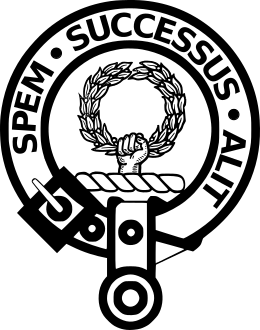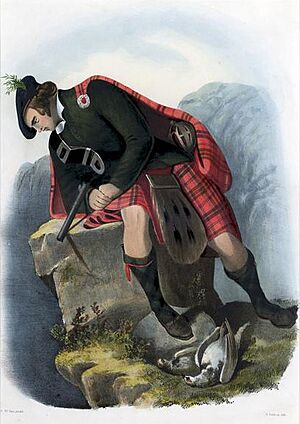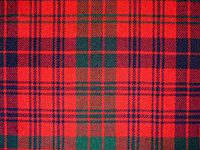Clan Ross facts for kids
Quick facts for kids Clan Ross |
|||
|---|---|---|---|
| Clann Anndrais or Na Rosaich | |||

Crest: A dexter hand holding a garland of laurel
|
|||
| Motto | Spem Successus Alit (Success Nourishes Hope) | ||
| Profile | |||
| Region | Highland | ||
| District | Ross | ||
| Plant badge | Juniper, or bearberry | ||
| Pipe music | The Earl of Ross's March | ||
| Chief | |||
 |
|||
| Chief of the Hereditary Coat of Arms of Ross, David Campbell Ross of Ross and Balnagown | |||
| The Chief of Clan Ross | |||
| Historic seat | Balnagown Castle | ||
|
|||
|
|||
|
|||
|
|||
|
|||
Clan Ross (Scottish Gaelic: Clann Anndrais) is a famous Scottish clan from the Highlands. The first leaders of the clan were the original Earls of Ross.
Contents
History of Clan Ross
How Did Clan Ross Begin?
The first known chief of Clan Ross was a man named "Fearcher Mac an t-Sagirt". This name means "son of the priest" in English. It suggests his family came from a long line of religious leaders.
Fearchar was a big help to King Alexander II of Scotland (who ruled from 1214 to 1249). He helped the King stop a rebellion by Donald Bane, who wanted to be king instead. Because of his loyalty, King Alexander II made Fearchar a knight. By 1234, he was officially given the important title of Earl of Ross.
Around 1250, Fearchar's son, William, was kidnapped during a revolt against his father's rule. Luckily, the Munros helped rescue him. As a reward, the Munros received land and became close allies of the powerful Ross family.
Clan Ross in the Wars for Independence
During the Wars of Scottish Independence, Clan Ross fought against the English. At the Battle of Dunbar (1296), their chief, the Earl of Ross, was captured. For a short time, William II, Earl of Ross sided with the English. However, he later chose to support Robert the Bruce, the Scottish King.
The Clan Ross fought bravely with King Robert the Bruce. Earl Fearchar's grandson, William, led the clan at the famous Battle of Bannockburn in 1314. This was a major victory for Scotland. Later, Hugh, Earl of Ross, was killed fighting at the Battle of Halidon Hill in 1333.
What Happened in the 1400s?
William III, Earl of Ross (the 6th Earl) died without any sons. This meant the title of Earl of Ross and the leadership of Clan Ross became separate. The chiefship of the clan went to Earl William's brother, Hugh Ross of Rariches. He was given the lands of Balnagown in 1374.
The Earldom of Ross passed through a female family line. This caused a big argument between two powerful leaders: the Lord of the Isles and the Duke of Albany. This argument led to the Battle of Harlaw in 1411. In this battle, Clan Ross fought as Highlanders, supporting the Lord of the Isles against an army from the Scottish Lowlands.
The Rosses also fought in France at the Battle of Verneuil in 1424, against the English. After this battle, the Earldom of Ross went back to the Scottish Crown. When King James I of Scotland returned from being held captive in England, he gave the Earldom back to the family of Alexander MacDonald, the Lord of the Isles.
In the late 1400s, Clan Mackay and Clan Ross had a long-standing feud. This led to the Battle of Tarbat in 1486, where the Mackays were defeated and their chief was killed. However, the Rosses were then defeated at the Battle of Aldy Charrish, and the Ross chief was killed.
In 1496, the King tried to make peace between the Rosses and Mackays. He ordered their chiefs to meet and agree to stop fighting. If they didn't, they would have to pay a large fine. The Mackays continued to raid the Rosses for a while, but then they started feuding with Clan Sutherland, and the raids on the Rosses stopped.
Clan Ross in the 1500s
A record of Clan Ross mentions Hugh Ross, a relative of the Balnagowan Rosses, who was killed at the Battle of Achnashellach in 1504 or 1505.
During the Anglo-Scottish Wars, John Ross, 2nd Lord Ross of Halkhead died leading his forces against the English at the Battle of Flodden on September 9, 1513.
Chief Alexander Ross, 9th of Balnagowan (who died in 1592), was known for being very forceful. He would often take lands and make his clan members sign agreements that benefited him, ignoring the law. He was even put in Tantallon Castle for a time. He was released on the condition that he would live peacefully, but he didn't. His own son, George, was given permission to use force against him, but Alexander was never caught. He died in 1592.
Clan Ross in the 1600s: Civil War Times
George, the 10th Chief of Balnagowan, was the first Ross chief to go to university. He studied at St Andrew's University. However, he also became known for causing trouble and died in 1615. His son, David, the 11th Chief, was much more peaceful and followed the law. David died in 1632, and his son, also named David, became chief.
David Ross, the 12th Chief of Balnagowan, signed the National Covenant in 1638. This was an important agreement for many Scots. He later joined the royalists for a short time but then became a Covenanter again. He was present when James Graham, 1st Marquess of Montrose was defeated at the Battle of Carbisdale in 1650. In this battle, Clan Ross and Clan Munro fought for the Scottish Government and defeated the royalist army.
David Ross, 12th of Balnagowan, later led some of the clan at the Battle of Worcester in 1651. He was captured there and imprisoned in the Tower of London. He is believed to have died there in 1653 and was buried in Westminster.
In 1689, 100 men from Clan Ross took over Castle Leod. They did this to keep an eye on the movements of the Jacobite Mackenzies, who supported the exiled King James VII.
Clan Ross in the 1700s
The Jacobite Risings
In 1715, during a Jacobite rising, Clan Ross, along with their allies the Clan Munro, Clan Mackay, and Clan Sutherland, had to retreat. They were outnumbered by a larger force of Jacobites led by William Mackenzie, 5th Earl of Seaforth, chief of the Clan Mackenzie. This event is known as the Skirmish of Alness.
In 1719, a group of men from Clan Ross fought for the government at the Battle of Glen Shiel. The Jacobites, including the Mackenzies, were defeated in this battle.
In 1721, a small group of Clan Ross men, led by William Ross, 6th of Pitcalnie, went to collect rent from Mackenzie lands. They were defeated by a much larger Mackenzie force at the Battle of Glen Affric. A report from 1724 estimated that the Rosses and Munros together could gather about 700 men for battle.
Fighting in France
Col. Charles, 13th Lord Ross of Hawkhead, was killed in 1745. He was leading some clan members at the Battle of Fontenoy in France, fighting against the French.
The Jacobite Rising of 1745
During the Jacobite rising of 1745, the main chief of Clan Ross was Alexander Ross of Pitcalnie. He was a strong supporter of the British government (the Hanoverian side). Alexander's uncle, Duncan Forbes of Culloden, was a very important judge for King George II of Great Britain. Duncan Forbes and Alexander Ross raised a special group of Highland soldiers to protect Inverness Castle from the Jacobites.
While most of Clan Ross supported the government, a few individuals joined the Jacobites. One such person was John Ross. On the day before the Battle of Culloden, about 200 Jacobite soldiers were ambushed by pro-government Scots at the Battle of Littleferry. Only a few survived. John Ross escaped but was put on a list of rebels.
Today, the Balnagowan estate is no longer owned by the Ross family. It belongs to Mohammed Fayed, who has spent a lot of money improving the estate and restoring the castle. The current Chief of Clan Ross lives in Perthshire.
Who is the Chief of Clan Ross?
- The current chief of Clan Ross is Baron David Campbell Ross, of Ross and Balnagowan.
Clan Ross Tartans
Clan Ross has three main tartans:
- Ross Red tartan
- Ross Dress tartan (modern & ancient styles)
- Ross Hunting tartan (modern, ancient & weathered styles)
Castles of Clan Ross
- Balnagown Castle, located eight miles north-east of Alness, was first built by the Rosses in 1375. It was expanded over the years. The Ross chiefs lost the castle in the 1700s because of debt, but it was bought by another branch of the Ross family, the Rosses of Hawkhead. The castle stayed with the Ross family until 1978. There are stories of two ghosts at the castle.
- Hawkhead Castle was near Paisley in Renfrewshire. It had a strong tower that was later made part of a larger house. The Rosses owned Hawkhead from the mid-1400s and built the original castle.
- Arnage Castle, near Ellon, Aberdeenshire, is a unique Z-shaped tower house. It was sold to Provost John Ross, a leader in Aberdeen, in 1702.
- Balconie Castle, near Alness, Ross and Cromarty, was owned by the Earls of Ross.
- Caisteal nan Corr, also called Invercassley, near Lairg in Sutherland, has only small remains of a tower house that was once held by the Rosses.
- Pitcalnie Castle, near Cromarty, was originally a Munro castle but passed to the Rosses in the 1700s.
- Portencross Castle, also known as Ardneil Castle, near West Kilbride in Ayrshire, was first held by the Rosses. It passed to the Clan Boyd after the Wars of Scottish Independence.
- Sanquhar Castle near Sanquhar in Dumfries and Galloway was once held by the Rosses. It later passed to the Clan Crichton and then to the Clan Douglas.
- Shandwick Castle, near Balintore, Easter Ross, was held by the Rosses of Shandwick. The current chiefs of Clan Ross come from this line. Sir Ronald Ross of Shandwick was a famous doctor who discovered how Malaria is spread.
- Tain Through Time in Tain, Ross and Cromarty, has a special Clan Ross center with information about the family.
Images for kids
-
Balnagown Castle was once the home of the chiefs of Clan Ross.
See Also




